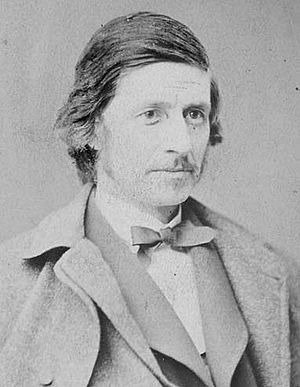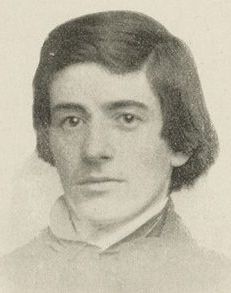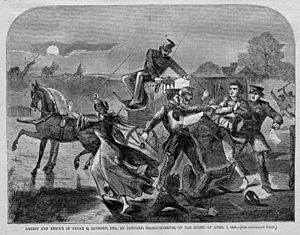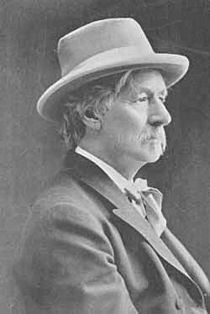Franklin Benjamin Sanborn facts for kids
Franklin Benjamin Sanborn (born December 15, 1831 – died February 24, 1917) was an important American journalist, teacher, and writer. He was also a social reformer and an abolitionist, meaning he worked hard to end slavery. Sanborn studied society and wrote early books about many key figures in American transcendentalism, a way of thinking that focused on spiritual and individual ideas.
In 1865, he started the American Social Science Association. Its goal was "to treat wisely the great social problems of the day." He was also part of a secret group called the Secret Six. This group helped fund John Brown's Raid on Harpers Ferry, a famous event in the fight against slavery. Sanborn was the one who introduced John Brown to the other members of this group.
Contents
Franklin Sanborn's Life Story
Growing Up and Getting an Education
Franklin Sanborn was born in Hampton Falls, New Hampshire. His parents were Aaron and Lydia Sanborn. From a very young age, he believed he could make a big difference in the world. When he was just nine, he read newspapers like The National Era and New-York Tribune. These papers talked about ending slavery. Franklin then told his family that slavery was wrong and that the United States Constitution should be changed.
In 1850, a future wife, Ariana Walker, suggested he study with a tutor named John Gibson Hoyt. Franklin focused on Greek for a year. After that, he went to Phillips Exeter Academy. He then attended Harvard and graduated in 1855. One of his friends at Harvard was Edwin Morton, who later worked for Gerrit Smith, another important figure.
Working for Change: Sanborn's Career
Sanborn was very active in politics. He was a member of the Free Soil Party in New Hampshire and Massachusetts. This party opposed the spread of slavery into new parts of the country. In 1856, he became the secretary of the Massachusetts State Kansas Committee. This role brought him close to John Brown, a famous abolitionist.
Sanborn was one of six powerful men who supported John Brown's plan. This plan led to the raid on Harpers Ferry in October 1859. This group became known as the Secret Six. Even though Sanborn said he didn't know about the attack beforehand, he always defended John Brown. He also helped support Brown's wife and children after the raid.
A Dramatic Arrest Attempt
On April 3, 1860, five federal marshals came to Sanborn's home in Concord, Massachusetts. They handcuffed him and tried to force him into a carriage. They wanted to take him to Washington to answer questions about his connection to John Brown. But about 150 townspeople heard the church bells ringing and rushed to Sanborn's defense.
A judge named Lemuel Shaw quickly issued a special order called a writ of habeas corpus. This order officially demanded that the marshals release Sanborn. The attempt to arrest him failed because the townspeople stood up for him. Louisa May Alcott, a famous writer, even wrote about the exciting event.
Journalism and Social Work
From 1863 to 1868, Sanborn was an editor for The Commonwealth newspaper in Boston. He also edited the Journal of Social Science for many years. From 1868 to 1914, he was a writer for the Springfield Republican newspaper.
He helped start many important groups. These included the American Social Science Association, the National Prison Association, and the National Conference of Charities. He also helped create the Clarke School for the Deaf and the Massachusetts Infant Asylum. Sanborn was also involved with the Concord School of Philosophy. He gave lectures at colleges like Cornell, Smith, and Wellesley.
In 1863, he became the secretary of the Massachusetts State Board of Charities. This was the first board of its kind in America. He worked to improve how charities were run. In 1875, he investigated problems at the Tewksbury almshouse, a place for the poor. His work led to important changes there. In 1879, he helped reorganize Massachusetts charities, especially for the care of children and people with mental illness.
Sanborn's Family Life
Sanborn lived in Concord, Massachusetts. He was married twice. His first wife, Ariana Walker, died just eight days after they married in 1854. Later, he tried to marry Edith Emerson, the daughter of famous writer Ralph Waldo Emerson. However, she turned him down.
In 1862, he married his cousin, Louisa Augusta Leavitt. She was a schoolteacher at the Concord school Sanborn had founded. They were married in Boston. Franklin and Louisa had three sons: Thomas Parker Sanborn, Victor Channing Sanborn, and Francis Bachiler Sanborn.
In 1880, Frank Sanborn built a large house in Concord, right by the Sudbury River. He even put a plaque with his first wife's name, Ariana, on the house. In 1891, he invited his old friend, the poet Ellery Channing, to live with him. Channing stayed there until he died in 1901.
His Final Years and Legacy
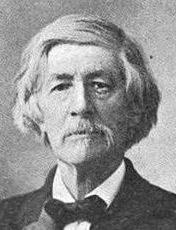
Frank Sanborn died on February 24, 1917. He was visiting his son Francis in New Jersey when he was hit by a railroad baggage cart. He broke his hip and passed away. He was buried in Sleepy Hollow Cemetery, Concord in Concord. His grave is near those of his friends and mentors, including Ralph Waldo Emerson and Henry Thoreau.
After his death, the flags in Concord were flown at half-mast for three days. The Massachusetts House of Representatives recognized Sanborn's dedication. They praised his work for people who were struggling, sick, or looked down upon. They also mentioned his role as a trusted advisor to John Brown, which led to his arrest and mistreatment.
People had different opinions of Sanborn. The poet Walt Whitman called him "a fighter... a revolutionary crusader." Henry David Thoreau worried that Sanborn was "only too steadfast and earnest." In his later years, Sanborn was seen as a respected figure from an earlier time. He was a tall and memorable person in Boston and Concord.
Sanborn's Published Works
Franklin Sanborn wrote many books, especially biographies of famous people. Here are some of his works:
- Thoreau (1872)
- Dr. S. G. Howe (1891)
- A. Bronson Alcott: His Life and Philosophy (with William Torrey Harris) (1893)
- Emerson (1895)
- Personality of Thoreau (1902)
- Personality of Emerson (1903)
- A History of New Hampshire (1904)
- Hawthorne and His Friends (1908)
- Bronson Alcott at Fruitlands (1908)
- Recollections of Seventy Years (1909)
- Thoreau and his Earliest Writings (1914)
- Sixty years in Concord (1916)
He also wrote many articles for the Proceedings of the Massachusetts Historical Society. He edited writings by Theodore Parker, Newton's Lincoln and Herndon, and short biographies of Ellery Channing and Mrs. Abbott-Wood. Sanborn also edited several volumes of Thoreau's writings and other historical letters.
Archival Material
Many of Franklin Sanborn's original writings and letters are kept at the Houghton Library at Harvard University.
See also
- Thomas Parker Sanborn
- Victor Channing Sanborn
- Secret Six


